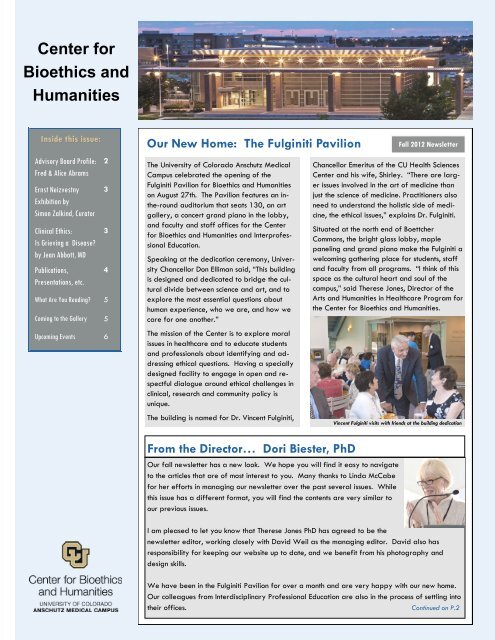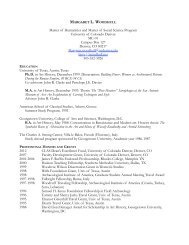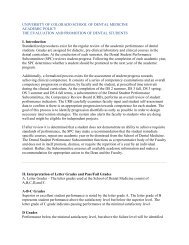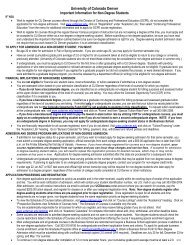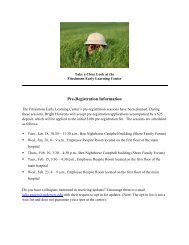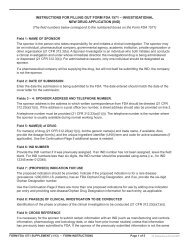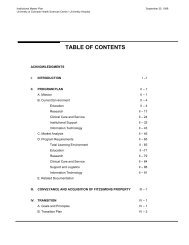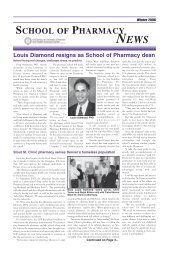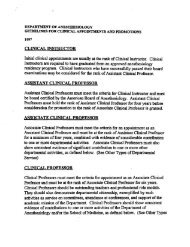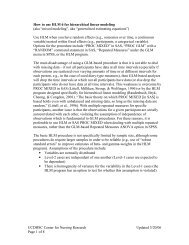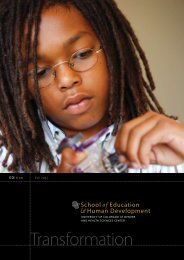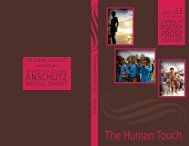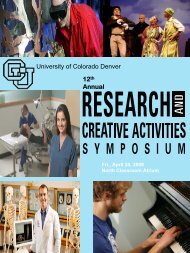Center for Bioethics and Humanities - University of Colorado Denver
Center for Bioethics and Humanities - University of Colorado Denver
Center for Bioethics and Humanities - University of Colorado Denver
You also want an ePaper? Increase the reach of your titles
YUMPU automatically turns print PDFs into web optimized ePapers that Google loves.
<strong>Center</strong> <strong>for</strong><br />
<strong>Bioethics</strong> <strong>and</strong><br />
<strong>Humanities</strong><br />
Inside this issue:<br />
Advisory Board Pr<strong>of</strong>ile:<br />
Fred & Alice Abrams<br />
Ernst Neizvestny<br />
Exhibition by<br />
Simon Zalkind, Curator<br />
Clinical Ethics:<br />
Is Grieving a Disease?<br />
by Jean Abbott, MD<br />
Publications,<br />
Presentations, etc.<br />
What Are You Reading?<br />
Coming to the Gallery<br />
2<br />
3<br />
3<br />
4<br />
5<br />
5<br />
Upcoming Events 6<br />
Our New Home: The Fulginiti Pavilion Fall 2012 Newsletter<br />
The <strong>University</strong> <strong>of</strong> <strong>Colorado</strong> Anschutz Medical<br />
Campus celebrated the opening <strong>of</strong> the<br />
Fulginiti Pavilion <strong>for</strong> <strong>Bioethics</strong> <strong>and</strong> <strong>Humanities</strong><br />
on August 27th. The Pavilion features an inthe-round<br />
auditorium that seats 130, an art<br />
gallery, a concert gr<strong>and</strong> piano in the lobby,<br />
<strong>and</strong> faculty <strong>and</strong> staff <strong>of</strong>fices <strong>for</strong> the <strong>Center</strong><br />
<strong>for</strong> <strong>Bioethics</strong> <strong>and</strong> <strong>Humanities</strong> <strong>and</strong> Interpr<strong>of</strong>essional<br />
Education.<br />
Speaking at the dedication ceremony, <strong>University</strong><br />
Chancellor Don Elliman said, “This building<br />
is designed <strong>and</strong> dedicated to bridge the cultural<br />
divide between science <strong>and</strong> art, <strong>and</strong> to<br />
explore the most essential questions about<br />
human experience, who we are, <strong>and</strong> how we<br />
care <strong>for</strong> one another.”<br />
The mission <strong>of</strong> the <strong>Center</strong> is to explore moral<br />
issues in healthcare <strong>and</strong> to educate students<br />
<strong>and</strong> pr<strong>of</strong>essionals about identifying <strong>and</strong> addressing<br />
ethical questions. Having a specially<br />
designed facility to engage in open <strong>and</strong> respectful<br />
dialogue around ethical challenges in<br />
clinical, research <strong>and</strong> community policy is<br />
unique.<br />
The building is named <strong>for</strong> Dr. Vincent Fulginiti,<br />
From the Director… Dori Biester, PhD<br />
Chancellor Emeritus <strong>of</strong> the CU Health Sciences<br />
<strong>Center</strong> <strong>and</strong> his wife, Shirley. “There are larger<br />
issues involved in the art <strong>of</strong> medicine than<br />
just the science <strong>of</strong> medicine. Practitioners also<br />
need to underst<strong>and</strong> the holistic side <strong>of</strong> medicine,<br />
the ethical issues,” explains Dr. Fulginiti.<br />
Situated at the north end <strong>of</strong> Boettcher<br />
Commons, the bright glass lobby, maple<br />
paneling <strong>and</strong> gr<strong>and</strong> piano make the Fulginiti a<br />
welcoming gathering place <strong>for</strong> students, staff<br />
<strong>and</strong> faculty from all programs. “I think <strong>of</strong> this<br />
space as the cultural heart <strong>and</strong> soul <strong>of</strong> the<br />
campus,” said Therese Jones, Director <strong>of</strong> the<br />
Arts <strong>and</strong> <strong>Humanities</strong> in Healthcare Program <strong>for</strong><br />
the <strong>Center</strong> <strong>for</strong> <strong>Bioethics</strong> <strong>and</strong> <strong>Humanities</strong>.<br />
Vincent Fulginiti visits with friends at the building dedication<br />
Our fall newsletter has a new look. We hope you will find it easy to navigate<br />
to the articles that are <strong>of</strong> most interest to you. Many thanks to Linda McCabe<br />
<strong>for</strong> her ef<strong>for</strong>ts in managing our newsletter over the past several issues. While<br />
this issue has a different <strong>for</strong>mat, you will find the contents are very similar to<br />
our previous issues.<br />
I am pleased to let you know that Therese Jones PhD has agreed to be the<br />
newsletter editor, working closely with David Weil as the managing editor. David also has<br />
responsibility <strong>for</strong> keeping our website up to date, <strong>and</strong> we benefit from his photography <strong>and</strong><br />
design skills.<br />
We have been in the Fulginiti Pavilion <strong>for</strong> over a month <strong>and</strong> are very happy with our new home.<br />
Our colleagues from Interdisciplinary Pr<strong>of</strong>essional Education are also in the process <strong>of</strong> settling into<br />
their <strong>of</strong>fices. Continued on P.2
Page 2<br />
Advisory Board Pr<strong>of</strong>ile: Fred <strong>and</strong> Alice Abrams<br />
Fred <strong>and</strong> Alice Abrams met<br />
at summer camp in New<br />
York, 62 years ago. She<br />
was a high school senior<br />
studying music <strong>and</strong> art, <strong>and</strong><br />
he was a senior pre-med at<br />
Cornell. They fell in love,<br />
married, <strong>and</strong> built their family<br />
<strong>and</strong> careers. They have<br />
three sons. Alice is an<br />
award-winning goldsmith,<br />
involved in numerous art <strong>and</strong><br />
cultural organizations. Fred<br />
practiced as an obstetrician/<br />
gynecologist, <strong>and</strong> when he<br />
started his clinical career,<br />
physicians <strong>and</strong> other practitioners<br />
were uncom<strong>for</strong>table<br />
talking about ethics. Although<br />
everyone claimed that<br />
he or she was “ethical” <strong>and</strong><br />
didn‟t need training to act<br />
right, there were no <strong>for</strong>ums<br />
to discuss the moral, clinical<br />
<strong>and</strong> social dilemmas in<br />
healthcare.<br />
In the late 1970s, after being<br />
inspired by a presentation<br />
given by Mary Walter,<br />
a nun from St. Joseph‟s hos-<br />
pital, Fred began teaching<br />
ethics courses at Rose Hospital.<br />
The bioethics programs<br />
he established drew hundreds<br />
<strong>of</strong> attendees from<br />
across America, Mexico <strong>and</strong><br />
Canada. He then founded<br />
the <strong>Center</strong> <strong>for</strong> Applied Biomedical<br />
Ethics at Rose Medical<br />
<strong>Center</strong> in 1983, which<br />
became the first center <strong>for</strong><br />
the study <strong>of</strong> ethical issues in<br />
a hospital setting in the U.S.<br />
Alice served as Chair <strong>of</strong> the<br />
Art Committee at Rose. She<br />
witnessed the stress <strong>of</strong> medical<br />
practice, the continual<br />
worries <strong>and</strong> pressures on<br />
physicians every day. Filling<br />
the soul with music, art, writing<br />
<strong>and</strong> dance helps balance<br />
<strong>and</strong> bridge the human elements<br />
that go along with<br />
disease. She‟s seen a shift in<br />
how students are trained<br />
today, compared to when<br />
Fred was a medical student.<br />
“That‟s what the <strong>Center</strong>‟s<br />
work is doing. Students are<br />
now being trained in both<br />
From the Director… continued.<br />
science <strong>and</strong> humanity,” she<br />
explains.<br />
The building is warm <strong>and</strong> inviting, the Gossard Forum is busy with multiple bookings <strong>and</strong> the concert<br />
gr<strong>and</strong> piano (a gift from the Rockley Family Foundation) is frequently played by skilled<br />
artists. If you have talent <strong>for</strong> playing the piano, you are invited to stop by the Foyer, sit down at<br />
the Seiler <strong>and</strong> allow us to enjoy your music….the theme from the Titanic is being played as I write<br />
this column. Wonderful.<br />
I invite you to stop by to see the Pavilion <strong>and</strong> also visit the Art Gallery. See page 3 <strong>for</strong> a description<br />
<strong>of</strong> our current exhibit.<br />
Although we have not yet completed the search <strong>for</strong> the <strong>Center</strong> Director, the process is active, <strong>and</strong><br />
we have a c<strong>and</strong>idate who will be returning <strong>for</strong> a second visit in November.<br />
<strong>Center</strong> <strong>for</strong> <strong>Bioethics</strong> <strong>and</strong> <strong>Humanities</strong>-Fall, 2012<br />
When Fred retired from<br />
practice he wrote a book,<br />
Doctors on the Edge, in<br />
which he shares the challenges<br />
that he <strong>and</strong> his<br />
patients faced. He encourages<br />
practitioners to<br />
deviate from convention,<br />
in the interest <strong>of</strong> their patients<br />
or community welfare.<br />
“When doctors take<br />
the time to sit at the bedside,<br />
particularly with end<br />
<strong>of</strong> life people, it‟s astonishing<br />
what people tell. Every individual has their story,” Abrams<br />
remarked. He was instrumental in writing legislation amending the<br />
<strong>Colorado</strong> manslaughter law, which in effect legalized “terminal sedation,”<br />
to relieve the suffering <strong>of</strong> patients in intractable pain.<br />
The Abrams‟ ef<strong>for</strong>ts on the Community Advisory Board have spanned<br />
decades. Alice explains, “As each generation continues to be part <strong>of</strong><br />
the <strong>Center</strong>, it will change. And it must change, because the culture<br />
changes, needs change, certain things have been fulfilled <strong>and</strong> others<br />
come about because <strong>of</strong> what we do here. We have to be able in the<br />
<strong>Center</strong>, to set up the circumstance where people are not just being<br />
told, but people who are ready to listen. And how do you find these<br />
people? That‟s what the Advisory Board is all about. Finding people<br />
who listen.”<br />
Interview & Photo by David M. Weil
<strong>Center</strong> <strong>for</strong> <strong>Bioethics</strong> <strong>and</strong> <strong>Humanities</strong>-Fall, 2012<br />
Art Gallery in the Fulginiti Pavilion<br />
ONLY PERSIST: Works by Ernst Neizvestny<br />
from the Collection <strong>of</strong> Wayne F. Yakes, MD<br />
Page 3<br />
The eloquence <strong>of</strong> Ernst Niezvestny‟s mature vision is inseparable from his experience<br />
as an artist during the most repressive periods <strong>of</strong> the Soviet regime.<br />
Those decades, when totalitarian ideologues sought to erase human presence<br />
from human culture oriented Niezvestny to place, with great urgency, the body<br />
at the center <strong>of</strong> his concern. Niezvestny‟s art seeks to restore to the embodied<br />
self the potential to manifest freedom. How we see the body mediates <strong>and</strong><br />
conditions every aspect <strong>of</strong> how we lead an embodied life.<br />
Niezvestny is a singularly resolute figure, loyal to the “old-fashioned” mediums <strong>of</strong> painting <strong>and</strong> sculpture <strong>and</strong> to classic subjects such as<br />
the human body <strong>and</strong> face. He creates art that seeks to integrate our conscious <strong>and</strong> unconscious processes <strong>and</strong> to translate the derelict<br />
remains <strong>of</strong> the failed ideologies <strong>of</strong> the 20th century into living metaphors <strong>of</strong> human dignity <strong>and</strong> moral commitment.<br />
The <strong>Center</strong> is most grateful to Dr. Wayne F. Yakes <strong>for</strong> the generous loan <strong>of</strong> this exhibit from his personal collection. This Neizvestny<br />
exhibition runs through November 8th. Gallery hours are Monday through Friday from 9am-5pm. A beautifully printed exhibition<br />
catalogue is available; contact Mary Lou Wallace at 303-724-3994 to request a copy.<br />
Clinical Ethics Corner by Jean Abbott, MD<br />
Is Grieving a Disease?<br />
The <strong>University</strong> <strong>of</strong> <strong>Colorado</strong> Hospital Ethics Committee had a very lively debate at a recent meeting,<br />
triggered by an editorial essay by Dr. Richard Friedman (Friedman RA. Grief, depression, <strong>and</strong> the DMS-5.<br />
New Eng J Med 2012; 366: 1855-7.) Friedman <strong>and</strong> others have written about the upcoming proposed<br />
changes in the Diagnostic <strong>and</strong> Statistical Manual <strong>of</strong> Mental Disorders (DSM-IV), the “Bible” <strong>of</strong> diagnosis in<br />
psychiatry. The proposed change would add grief to the list <strong>of</strong> pathologies under the broad category <strong>of</strong><br />
“depression.”<br />
Some questions we grappled with:<br />
- Is this an example <strong>of</strong> the medicalization <strong>of</strong> normal human experience?<br />
- Is this driven by the pharmaceutical industry in an ef<strong>for</strong>t to exp<strong>and</strong> indications <strong>for</strong><br />
anti-depressants?<br />
- Is bereavement pathologic? always? sometimes?<br />
Simon Zalkind, Exhibition Curator<br />
Friedman‟s objection to the new designation is that grieving persons can exhibit mild depression <strong>and</strong> sadness but usually is selflimited.<br />
There is such an entity as “complicated” grief, which lasts longer, is associated with cognitive disturbances <strong>and</strong> serious interference<br />
with daily living. A history <strong>of</strong> major depression is associated with recurrence in the context <strong>of</strong> loss, <strong>and</strong> 10-20% <strong>of</strong> people<br />
who are bereaved do have issues that might benefit from psychiatric care. But Friedman, as many <strong>of</strong> us on the Ethics Committee,<br />
argues that there is an essential difference between grief-related depression <strong>and</strong> major depression. The comment period <strong>for</strong> this<br />
proposed change is over, but the American Psychiatric Association website currently notes that, in response to many comments from<br />
the public, they will clarify the criteria by which bereavement is not “normal” <strong>and</strong> should be considered a mental disorder.
Page 4<br />
<strong>Center</strong> <strong>for</strong> <strong>Bioethics</strong> <strong>and</strong> <strong>Humanities</strong>-Fall, 2012<br />
Appointments, Awards, Grants, Memberships, Presentations, Publications, etc.<br />
Appointments:<br />
Dayna Matthew was appointed as Pr<strong>of</strong>essor in the School <strong>of</strong> Public Health, July 2012<br />
Awards:<br />
Dori Biester was recognized as an esteemed alumni <strong>of</strong> the CU College <strong>of</strong> Nursing Class <strong>of</strong> „94 at their September 2012 Annual<br />
Awards luncheon.<br />
Grants:<br />
Dayna Matthew is the recipient <strong>of</strong> an IMPACT Grant <strong>for</strong> Research in Health Disparities to fund a pilot project to examine how provider<br />
<strong>and</strong> patient implicit biases contribute to health disparities.<br />
Memberships:<br />
Jackie Glover <strong>and</strong> Tess Jones were both selected <strong>for</strong> membership in the Academy <strong>of</strong> Medical Educators. Members are chosen through<br />
a competitive process based upon accomplishments in aspects <strong>of</strong> medical education including: direct teaching, advising, mentorship,<br />
instructional development, curricular design, educational administration, leadership, educational scholarship <strong>and</strong> research. (September<br />
2012)<br />
Mary Lou Wallace successfully completed coursework <strong>and</strong> attained accreditation as a Certified Government Meeting Pr<strong>of</strong>essional,<br />
September 2012.<br />
Presentations:<br />
Marilyn Coors was Chair <strong>of</strong> the Organizing Committee <strong>for</strong> the 3rd Annual Research Ethics Conference: “Sharing Health Data <strong>for</strong> Research:<br />
How Much Should They Know about You <strong>and</strong> your Community?”<br />
Jackie Glover presented “Ethical Issues in Assisted Reproduction” to the <strong>Colorado</strong> Bar Association, September 2012. She also<br />
presented “Ethical Issues in Pediatrics” to the Boulder Community Hospital Ethics Committee, September 2012.<br />
Tess Jones presented a Plenary, “Coming Home: The Returning Soldier in Literature <strong>and</strong> Film,” at the Family Medicine Review, CU<br />
School <strong>of</strong> Medicine, June 2012. She also presented a paper, “Running the Risk: Studio Thinking in Medical Education,” at the Comics<br />
<strong>and</strong> Medicine Conference, <strong>University</strong> <strong>of</strong> Toronto, July 2012.<br />
Dayna Matthew presented “The Health Care Safety Net in a Post-Re<strong>for</strong>m World,” <strong>and</strong> is author <strong>of</strong> a chapter in the newly released<br />
book <strong>of</strong> the same name published by Rutgers <strong>University</strong> Press, at a roll-out event at George Washington <strong>University</strong>. She also<br />
participated in a <strong>Colorado</strong> Women‟s Leadership Forum, an invitation only discussion convened by Senator Michael Bennet, to discuss<br />
approaches to “Building A Better Health System While Reducing the National Debt” in October 2012. Finally Dayna was an invited<br />
participant in the invitation only, “Implementing Af<strong>for</strong>dable Insurance Exchanges Roundtable,” with 20 national <strong>and</strong> state level health<br />
law <strong>and</strong> policy experts to create a white paper to guide insurance exchange implementation.<br />
Publications:<br />
Marilyn Coors co-authored “Reporting Actionable Research Results: Shared Secrets Can Save Lives” in Science Translational Research,<br />
v.4 no. 141-44 (2012):18-21.<br />
Tess Jones published “Reflections in/<strong>and</strong> Writing: Pedagogy <strong>and</strong> Practice in Medical Education,” in Academic Medicine, May 2012.<br />
Tess Jones published “Minding the Gap(s): Liminality <strong>and</strong> Narrativity in Medical Student Writing,” in Literature <strong>and</strong> Medicine, Spring<br />
2012.
<strong>Center</strong> <strong>for</strong> <strong>Bioethics</strong> <strong>and</strong> <strong>Humanities</strong>-Fall, 2012<br />
What Are You Reading?<br />
Suggested literature from Therese Jones, PhD<br />
The short story, “The Doctor” by Andre Dubus, was first published in The New Yorker on April 26, 1969<br />
<strong>and</strong> later collected in Separate Flights (1975). I first encountered it last summer in a seminar on literature<br />
<strong>and</strong> medicine, <strong>and</strong> I will never <strong>for</strong>get the experience <strong>of</strong> hearing those two pages read aloud, paragraph<br />
by paragraph, by a group <strong>of</strong> us sitting around a table.<br />
The doctor in question is Art Castagnetto, an obstetrician out <strong>for</strong> a morning jog in early spring who encounters<br />
a terrible accident: a young boy pinned by a concrete slab in the rushing water <strong>of</strong> a swollen<br />
stream. He‟s “the doctor” whom all the neighbors know by name <strong>and</strong> by face, so they expect him to “do<br />
something.”<br />
Contact Tess Jones if you are interested in reading “The Doctor.”<br />
COMING TO THE ART GALLERY: Arts <strong>and</strong> <strong>Humanities</strong> in Healthcare Program<br />
Our next art exhibit, AIDS Adagio, opens on Thursday, December 13 <strong>and</strong> runs until February 15.<br />
The following description comes from curator, Simon Zalkind.<br />
“Cheating Death” by Wes Kennedy, 1987<br />
“Akedah” by Albert Winn, 1995<br />
Page 5<br />
Andre Dubus<br />
“Since the mid-1980‟s photography has played a critical role in shaping public perception<br />
<strong>of</strong> AIDS. AIDS Adagio presents the work <strong>of</strong> two artists, Albert Winn <strong>and</strong> Wes Kennedy –<br />
one living, one deceased – whose work is about the experience <strong>of</strong> AIDS yet who respond in<br />
very different ways to their condition. Kennedy‟s work is poetic, surreal <strong>and</strong> elegiac. Winn‟s<br />
images are rooted in photo-documentary traditions that record, through very direct <strong>and</strong><br />
occasionally confrontational strategies, the daily, quotidian existence <strong>of</strong> a long-term AIDS<br />
survivor “managing” his domestic <strong>and</strong> personal life in the midst <strong>of</strong> his exhausting medical<br />
routines precarious life situation. Kennedy‟s art is suffused with a grotesque <strong>and</strong> traumatic<br />
beauty. Winn‟s work reminds us that his illness does not represent the sum total <strong>of</strong> his life.<br />
The pairing <strong>of</strong> these two artists makes clear that AIDS-related images are complex. They<br />
can be sublimely gorgeous, domestically ordinary, or troubling, confrontational representations.”<br />
Following AIDS Adagio, we have the once-in-a-lifetime opportunity <strong>of</strong> hosting an installation,<br />
The Four Questions, by Judy Chicago, which opens on Thursday, May 7 <strong>and</strong> runs<br />
through May 30. Chicago, creator <strong>of</strong> The Dinner Party - an iconic work <strong>of</strong> feminist American<br />
art – has been associated with a number <strong>of</strong> dissident themes <strong>and</strong> projects. In 1991, as<br />
part <strong>of</strong> a larger project dealing with the enormity <strong>of</strong> the Holocaust, Chicago <strong>and</strong> her husb<strong>and</strong>,<br />
the photographer Donald Woodman, created a series <strong>of</strong> paintings, drawings <strong>and</strong><br />
photographs that addresses foundational moral, political <strong>and</strong> medical issues central to how<br />
our culture views human beings <strong>and</strong> determines their experience <strong>and</strong> destiny. The works<br />
correlate aspects <strong>of</strong> Nazi racial “science” - the management <strong>of</strong> human genetic engineering<br />
- with parallels from contemporary culture, a culture which Chicago sees as possessing<br />
highly advanced scientific <strong>and</strong> technological capacities but lacking in ethical development<br />
<strong>and</strong> empathic responsiveness. In the process <strong>of</strong> creating these works Chicago invented<br />
a dramatic visual strategy that combines painting <strong>and</strong> photography, fusing images through<br />
an optical system <strong>of</strong> alternating “slats.” Depending on where one st<strong>and</strong>s in relation to the<br />
work one sees either an image derived from Holocaust documentation or, alternately, an<br />
image that references the contemporary situation.
<strong>Center</strong> <strong>for</strong> Bioethi cs <strong>and</strong> Hum anities<br />
<strong>University</strong> <strong>of</strong> <strong>Colorado</strong><br />
Fulginiti Pavilion <strong>for</strong> <strong>Bioethics</strong> <strong>and</strong> <strong>Humanities</strong><br />
13080 E. 19th Ave. Mailstop B137<br />
Aurora, CO 80045<br />
Phone: (303) 724-3994<br />
Fax: (303) 724-3997<br />
Editor-in-Chief: therese.jones@ucdenver.edu<br />
Managing Editor: david.weil@ucdenver.edu<br />
Web: www.coloradobioethics.org<br />
Peter Hulac, MD at recent Trisomy 13 & 18 Conference,<br />
held in the Gossard Forum <strong>of</strong> the Fulginiti Pavilion.<br />
UPCOMING<br />
EVENTS<br />
Mondays-Noon Art in Medicine Lectures through 12/19<br />
October 25 Robert Schrier, M.D. Recognition Event<br />
November 1 Café Ped<br />
November 14 Arrhythmias / Melomania Holiday Concert<br />
Nov. 30-Dec. 2 Rockley Family Foundation Musical Instrument Sale<br />
December 5 Raphael Campo; Inaugural Claman Lectureship<br />
December 3-6 ZATA Silent Auction <strong>and</strong> Art Exhibit<br />
December 13 Gallery Opening: AIDS Adagio<br />
About<br />
The Fulginiti Pavilion<br />
<strong>for</strong> <strong>Bioethics</strong> <strong>and</strong> <strong>Humanities</strong><br />
� Art Gallery hours are Monday through Friday from 9am-5pm.<br />
� The gr<strong>and</strong> piano in our lobby is open <strong>for</strong> use by students, faculty,<br />
staff <strong>and</strong> visitors. Thank you to the Rockley Family Foundation <strong>for</strong><br />
this donation.<br />
� The Gossard Forum is an in the round amphitheater seating 130.<br />
This unique space is designed to encourage discussion.<br />
� The Forum features 4 projection screens, audience microphones<br />
<strong>and</strong> outst<strong>and</strong>ing acoustics.<br />
� Light maple trim is featured throughout the Fulginiti Pavilion.<br />
� There are two small conference rooms in the facility: The UPI Conference<br />
Room on the 1st floor seats 14, <strong>and</strong> the Fulginiti Family<br />
Conference Room on the 2nd floor seats 12 people.<br />
� The <strong>Center</strong> <strong>for</strong> <strong>Bioethics</strong> <strong>and</strong> <strong>Humanities</strong> <strong>of</strong>fices are on the 2nd<br />
floor, <strong>and</strong> the Interpr<strong>of</strong>essional Education <strong>of</strong>fices are in the lower<br />
level.<br />
� Design <strong>of</strong> the building is by NAC Architecture with Stuart Craw<strong>for</strong>d<br />
as the principal designer.


